| Australian Terrier International
Meeting The Needs Of Aussie Owners Globally
© 2010 Australian Terrier International
February, 2012- Vol. 3, Issue 1
|
|
|
|
|
|
|
Dear Friends,
|
|
This month we celebrate love and affection, with the international holiday Saint Valentine’s Day also known simply as Valentine’s Day.
Our friends in Denmark call it Valentinsdag. In Finland Valentine’s Day is called Ystävänpäivä which translates into “Friend’s day.” In Estonia it is called Sõbrapäev. In some Latin American countries Valentine’s Day is known as “Día del Amor y la Amistad” (Day of Love and Friendship).
This month we share ideas on how to share that love with your favorite Aussie and Aussie friends.
To all of our ATI members and friends, we wish you a day, month and year filled with happiness and love.
Please be aware that viewing this newsletter on a regular computer is best. For iPad users you may wish to go to the website and view the pdf version.
Pamela Levy
Newsletter Editor
Photo Courtesy Of Cheryl Mechalke
|
|
|
|
Westminster Best Of Breed on Valentine’s Day |
|
Congratulations GCH Kambara’s Zebulon and owners
Anne and Craig Mitchell
To View Live Click Here Go To Terriers, Look for Australian Terriers an
|
We Remember With Love Our Seven Lifetime Members
|
| Combined, these devoted breeders have over 200 years of experience in the breed.
We thank them for their dedication and devotion to Australian Terriers.
1. Jennie Worthing – Maila Kennels (USA) June 2010
2. Hal Wilcox – Halice Kennels (USA) August 2010
 3. Orvokki Laamsa – Avocation Kennels (Finland) January 2011
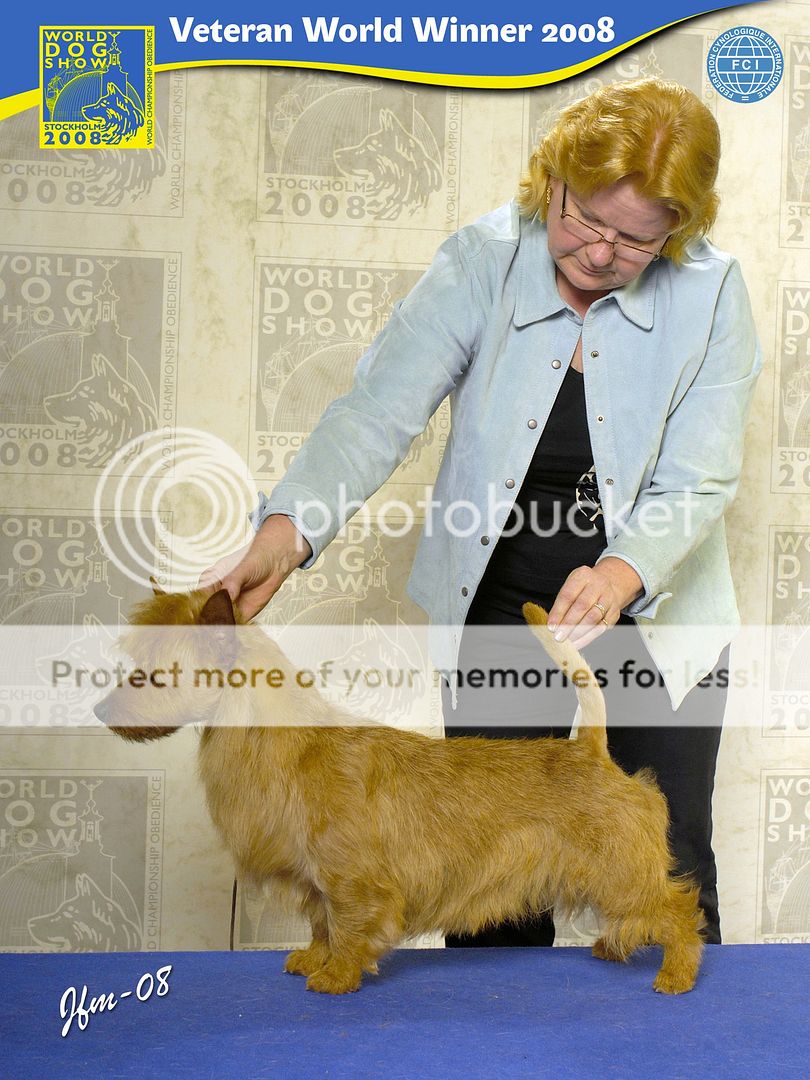
4. Jill Grenae – Tatong Kennels (Denmark) March 2011
5. Brenda Brown – Ralindi Kennels (UK) May 2011
5. Carin Sandahl – Twee-Dle-Dee Kennels (Sweden) June 2011
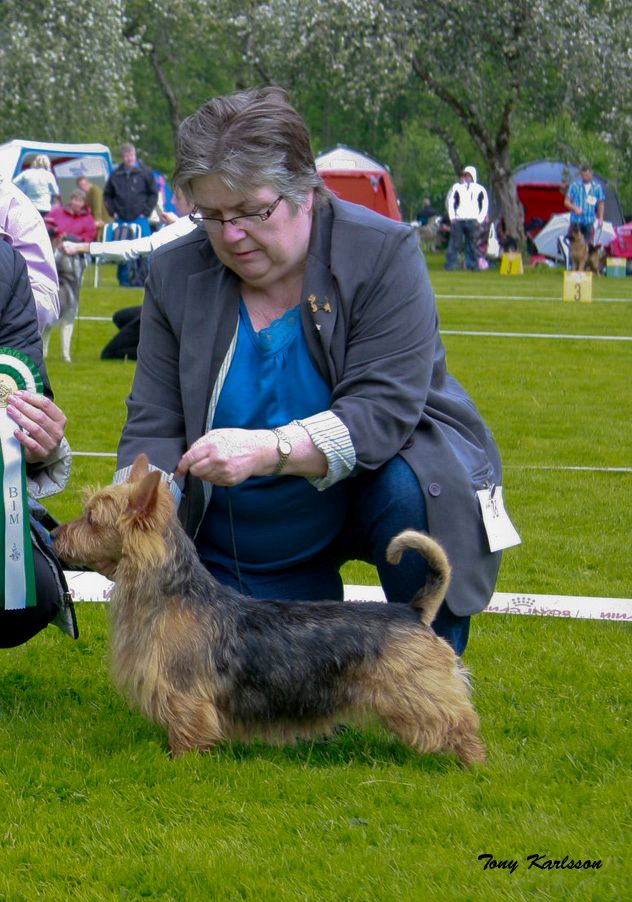
6. Sabine Baker – Aussome Kennels (USA) November 2011

7. Gillian Bartlett – Teraustralis Kennels (Australia) December 2011

|
|
Aussie Colors and “Blue Dog Syndrome”
|
Recently we have had several questions about the color of Aussies. The standard describes the Aussie as coming in one of three colors, red, blue/tan and sandy.
Several months ago we received photos from an experienced breeder asking if any of us had ever seen these different colored puppies in our litters. None of us ever had. This thoughtful breeder continued to try and learn more about these different colored puppies and decided to share her photos and knowledge with all of us. ATI is very grateful as this is wonderful educational information for all of us. To the breeder we want to say, “Thank you so very much for sharing with us!”
The “mommy” dog and puppies. You can see the one blue puppy
at the top of the puppy group.
The light “blue” and the dark “blue” puppies are marked and
also referred to as grey.
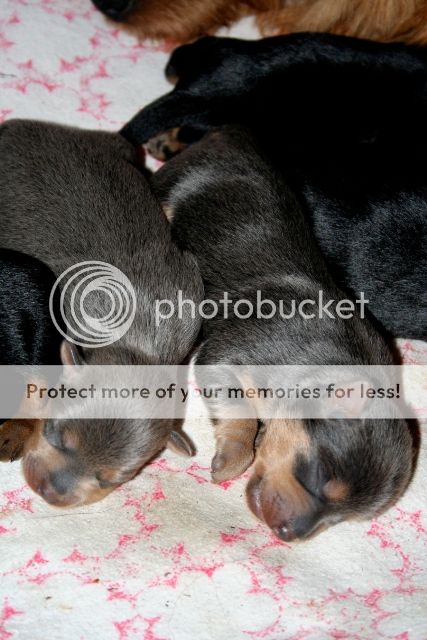 Light “blue” on left and dark “blue” on right.
Information about “Blue Dog Syndrome” in the Australian Terrier
“In our 11th litter we had, for the very first time, two puppies that appeared to have blue or grey coats and not the traditional black.”
“We now know what it is and it is called the “Blue-Dog-Syndrome. It’s a
dilution-gene. The color is diluted and the black turns to grey and the tan is brighter,” according to the breeder.
The dilution-gene is also found in other breeds where this syndrome is more common. It is also found in Dobermans, Beagles, Deutscher Pinschers, Yorkshire Terriers, Poodles, English Bulldogs, Whippets and many other breeds. In some cases breeders purposely mated carriers of the recessive gene in order to obtain genetically pure “blue” animals.
It is not difficult to eliminate the “Blue Dog Syndrome” in dogs. A one-time genetic test which costs only 35 Euros at Laboklin makes it possible. It requires just 1ml
of EDTA blood. In the future I will definitely have animals I plan to breed tested at Laboklin for the dilution gene. When only one parent is a carrier (D/d) there is no risk. If both parents are carriers (D/d) the odds of getting pure d/d puppies are 25%.
Our test results showed that our two “gray” or “blue” puppies are genotype d/d, which means they exhibit the “Blue Dog Syndrome.” This means that both parents must carry the D/d gene. Normally, in the Aussie, the gene is D/D. Both parents of my litter have D/d. Both parents in a given litter must have D/d for the dilution-gene d/d to occur.
This means that the coat color, because of the color dilution gene, is only expressed in a diluted form (See photos)
In my 11 years of breeding I have never heard of this in our breed. Perhaps it is the same for other breeders? This is why I would like to pass this information on to you, because this genetic test makes it very easy to eliminate the possibility of producing “blue” Aussie puppies.
Light Blue Puppy
Light Blue Puppy on left
Dark Blue Puppy
Dark Blue Puppy
Light Blue Puppy at 11 weeks old.
Dark Blue Puppy at 11 weeks old.
Dark Blue Puppy on left and Light Blue Puppy on right at 11 weeks.
If you want more info, here’s a web page on coat color inheritance:
More Information Regarding The Color Of Aussies.
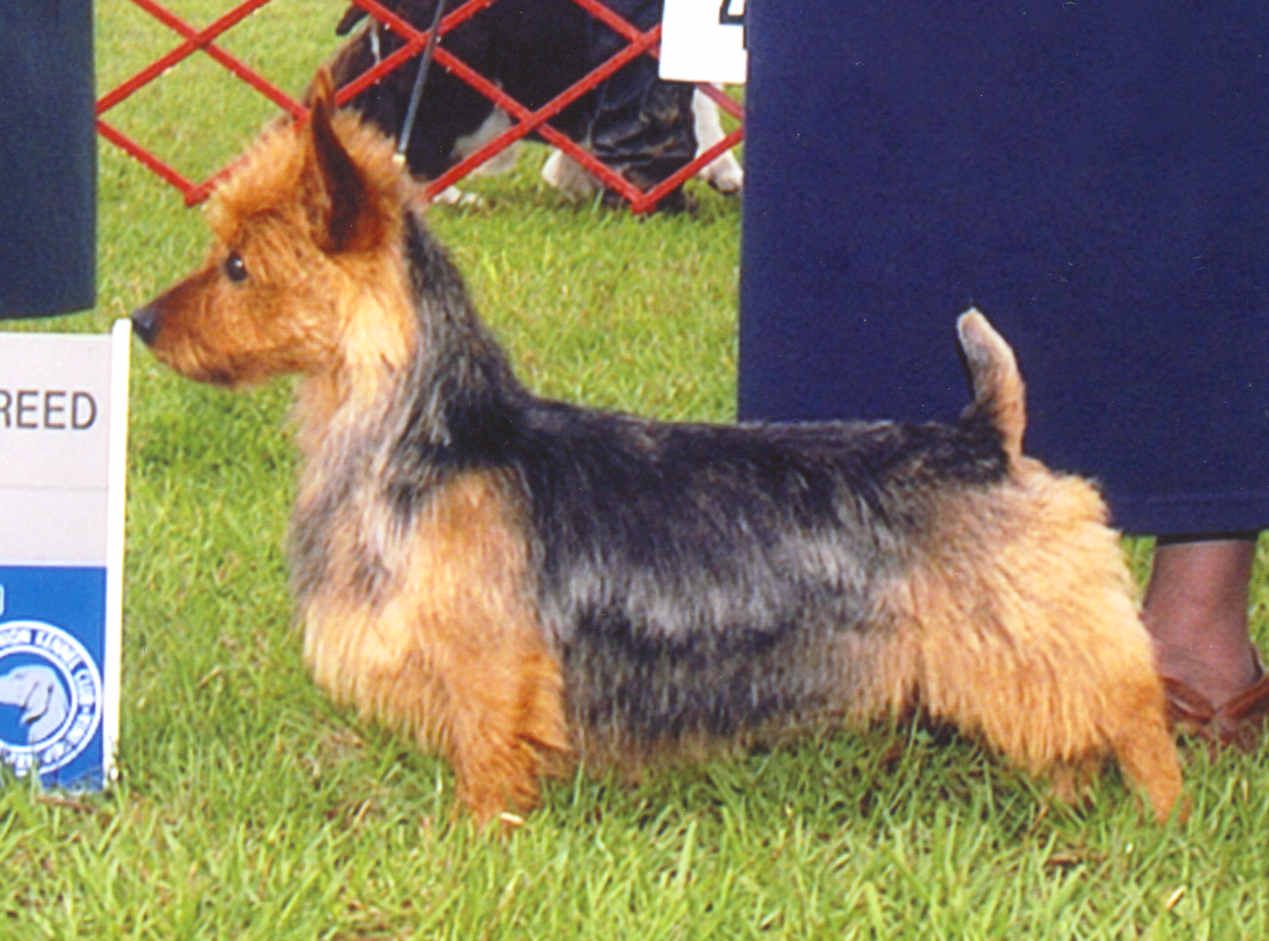 Example of a Blue/Tan Aussie
Sue Holsinger, Redwing Kennels, describes the difference between red and sandy colored Aussies. Red can be any shade, from a light sandy to a deep red. The difference between a true sandy and a light red is that a true sandy has no tipped shading on the coat or darker hair anywhere. They are an even butterscotch color overall.
Kirsi Ola reminds us that, “the colour sandy was the original one, the standard from the year 1873 only mentioned blue and tan and sandy. The colour red was added more than 20 years later on in 1896.”
Below are examples of red and sandy Aussies. Many breeders admit to never having seen a sandy colored Aussie. There are different degrees of red.
Our next issue will have further clarification on the color gene.

“Lucy” a Red Aussie Photo Courtesy of Sue Holsinger
A Sandy Colored Aussie Photo Taken by Irma Harden(FI)
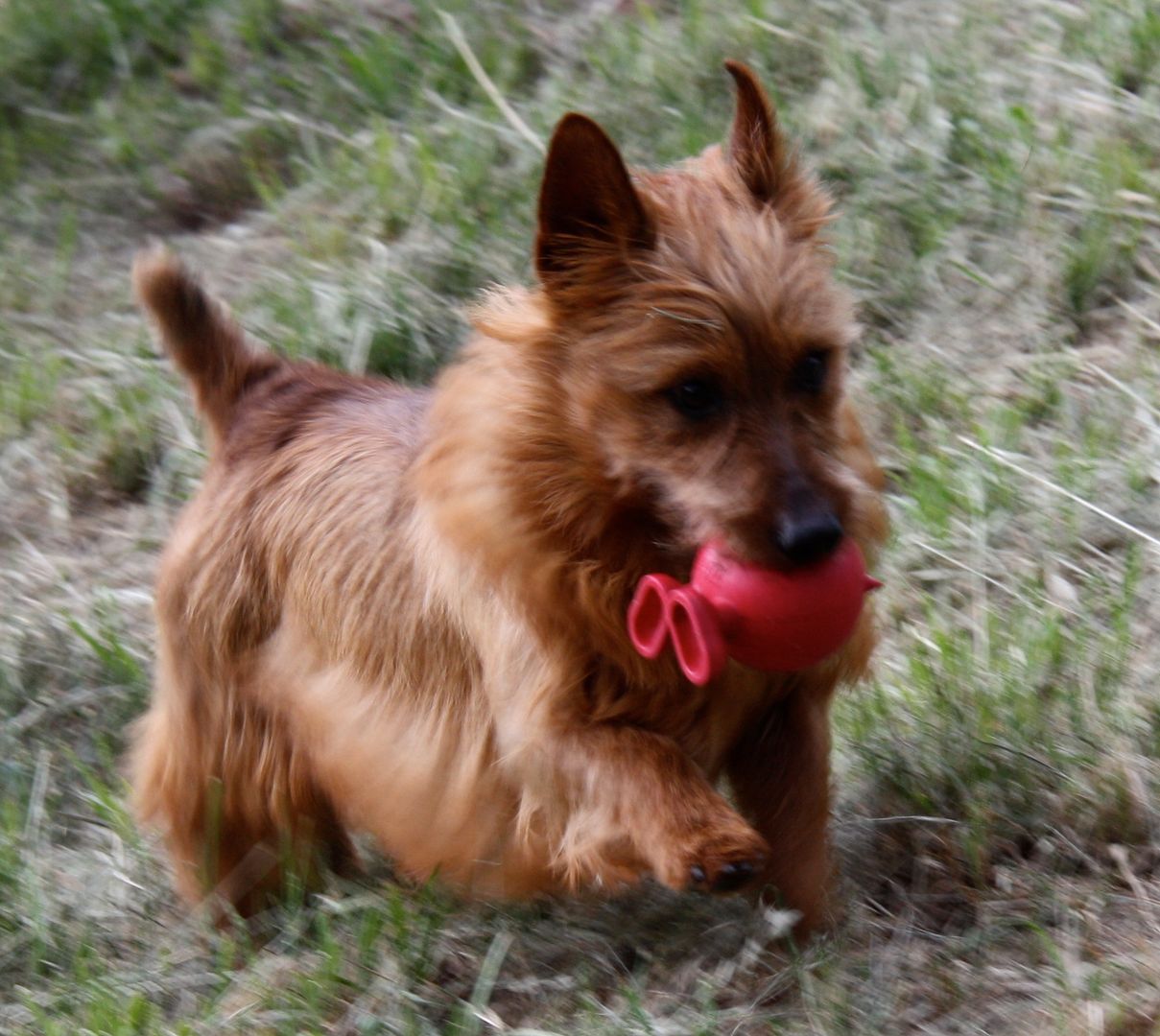
“Wellington” is a deeper shade of red.

A Sandy Colored Aussie Photo By Diane Riley (NZ)
“Ralfie” is a puppy that is a deep shade of red.
|
We Love Talking With Our Breeder/Judges
|
|
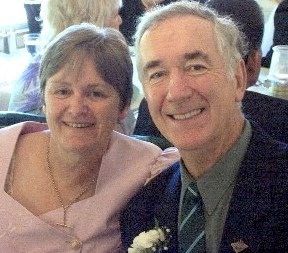
Diana & Trevor Fenton
When Trevor and I first came into Aussies we did so after many years involved in the dog fraternity; we were “downsizing” from pointers which we then owned.
We had no real intentions of breeding but, as many who have been owned by Aussies know, we were beguiled by them. They are “big dogs” in a small package that have an addictive intelligence as well as an indomitable courage tempered by a loyal gentleness.
In 2003 an offer to judge the Papago Labrador Retriever Club show combined with Sahuarto State Kennel Club shows led me to Arizona, USA. Although not judging Aussies I was able to observe many of the top Aussies of that era strutting their stuff. Impressed is not an adequate description of how I felt but the variety of style yet with conformation to what is my interpretation of the standard imbued me with the realism that the quality I wanted to breed with was indeed out of Australia.
Subsequent to this I was invited to judge the Finnish Australian Terrier Club Unofficial Show in 2005 with an entry in the 70’s and have since judged Aussies at Finnish AB Championship shows in 2008 and 2011. I also attended the world show in Stockholm in 2008 and the World Terrier Show where an Australian judge was doing the honours. In 2006 I attended Crufts and observed the Aussies. At all of these shows I have been greatly impressed with the quality throughout the Aussies. I believe I have been fortunate to see some of the best ever Aussiesthroughout my travels.
My first visit to Finland was not long after tail docking had been banned in New South Wales, the State in which I live. The undocked tails of our Aussies were very poor, high set curling or hanging over the back, poor shape and detracting often from the outline of the dog. Finland on the other hand seemed to have by and large well placed tails which were held high. This gave me comfort that in Australia we could overcome this new problem and in 2012 we do appear to have been mostly successful. However, as an All Breeds Judge I have to contend with undocked tails in many other breeds that have fared very much worse than Aussies.
(I am originally a working gundog exhibitor and breeder.)
I simply ignore the tail and concentrate on the tail set and hindquarters.
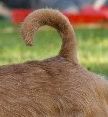 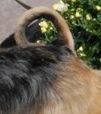
I usually place my hand over the point of where the tail would be docked and stand back a little to observe the overall outline. Not a perfect solution but one that works for me.
 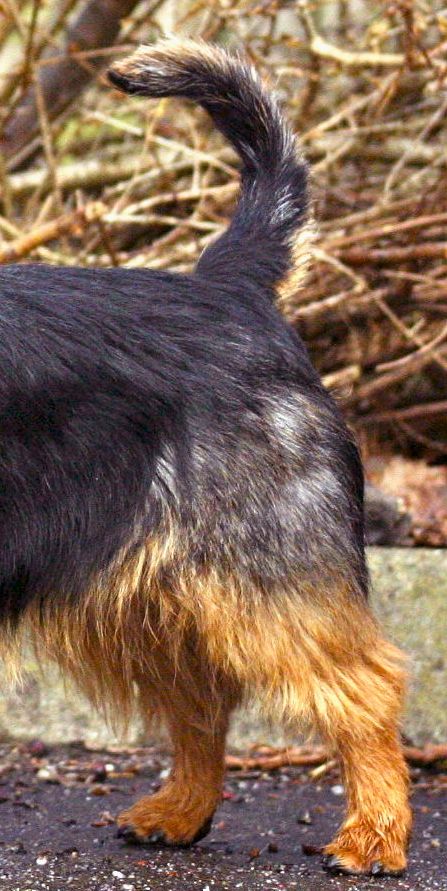
I never penalise a poor undocked tail but I will penalise poor placement and incorrect hindquarters. My preference, you may ask, is a docked tail, but I acknowledge that the rest of the dog is emphasised far more in the standard and that is what I judge to. I would never and neither would I expect any judge to penalise an undocked tail over the docked one unless of course the standard of the country in which you are judging stipulates ONLY undocked.
I have also judged Aussies in New Zealand but they too are extending their breeding outside their own country for similar reasons that I have.
Australia also is importing more Aussies, from USA, New Zealand and Finland. This will ultimately extend our gene pool. A precaution here should be the different styles and how are they going to blend, if at all.
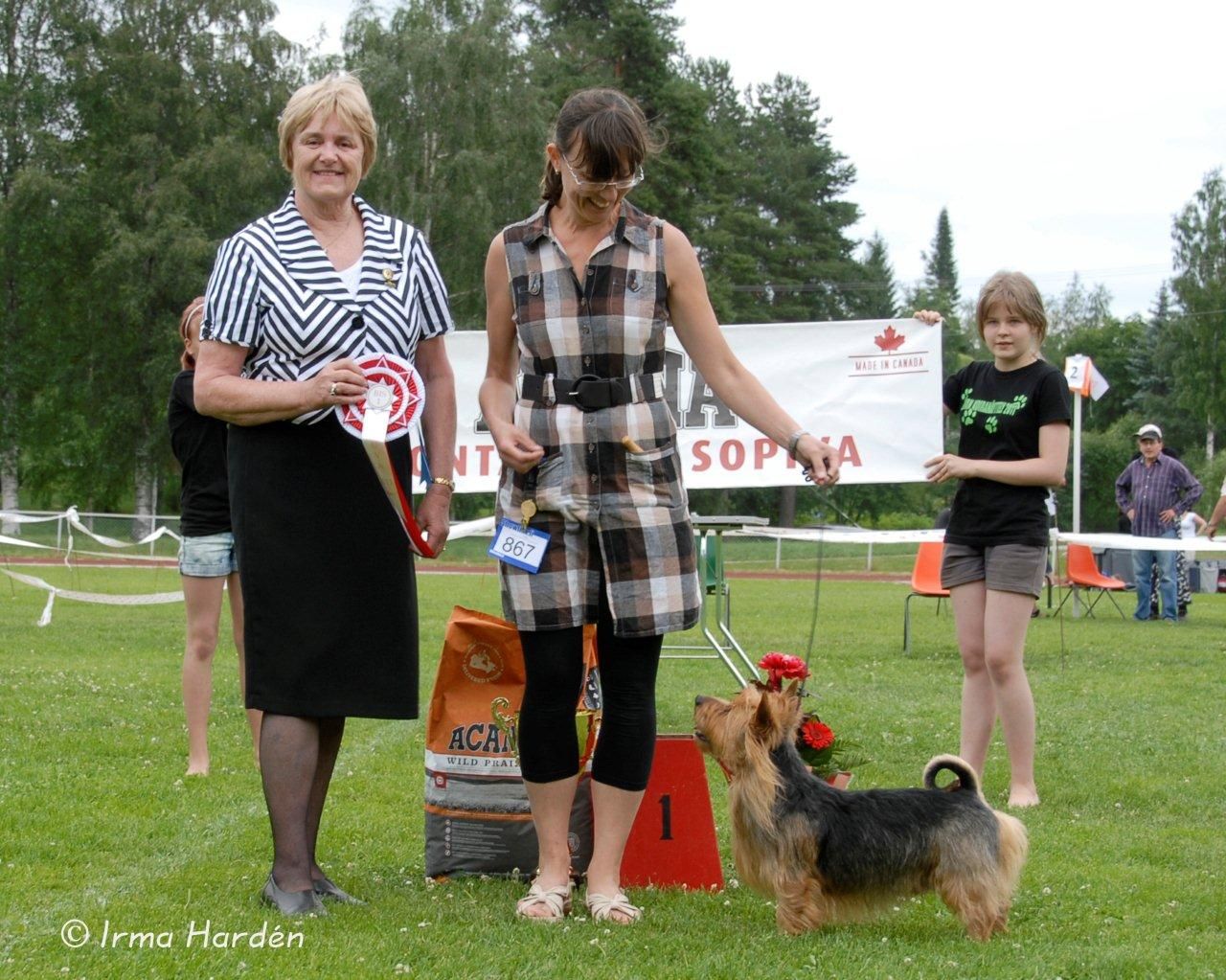
Judge Diana Fenton awarding a Best-In-Show
The dog is CH Melukylän Q-luu Kauas and Handled by Kirsi Ola of Melukylän Kennels. The show was Juva All-Breed held on July 2nd and 3rd, 2011.
Photo by Irma Harden
Coat colour in Aussies is an interesting area. The standard varies slightly but significantly between USA and other countries. In USA the colour silver blue is allowed and deleted from other standards.
However it is incumbent on judges to understand just what a blue coat looks like and not fall into the trap of awarding black coats. I would rather any varying shade of blue than black.
Coat texture is important in my assessment of an Aussie. The body coat should be harsh, dense and straight with a soft textured undercoat. Some would describe the texture to be that of human hair. The Aussie was developed for Australian conditions which are not equal to the harsh conditions for which Cairn and West Highland White were bred, and therefore their coat texture is not quite as harsh as these two breeds.
Soft coats are often a problem and expert groomers are adept at overcoming perceptions of “soft coats.” My only comment here is for exhibitors to be cognisant of the judge’s breed involvement and knowledge.
If asked what one feature might I forgive over another when judging Aussies is almost impossible to answer. For me an adult Aussie must have that “hard bitten expression” with a definite ruff, a correct coat and good bone (neither over done nor underdone). An excellent Aussie with a lighter eye would not be penalised over an Aussie with an incorrect coat for example. It simply depends on which hallmarks of the breed are evident (or not).
As a breeder and judge, terrier temperament is a must. I have no problem with an Aussie strutting his stuff in the ring or maintaining his dignity depending on the moment, and puppies are allowed to be less than perfect statues.
There have been many Aussies I would love to own and not all are the same style. As a breeder all you can hope for is that careful selection will result in an Aussiewho has all the hallmarks of the breed, such as appearance, expression, coat, colour, conformation with correct movement and an excellent temperament. An Aussie should be easy to live with and eager to show.
Diana Fenton
|
An International Love Affair
|
|
A conversation with Diana Fenton (AU) and Jenni Wahteristo (FI)
Thank you both for taking the time to talk to us and share your thoughts.
Mrs. Fenton you imported a female from the USA. What made you decide on importing that particular dog?
Judge Diana Fenton: When we started to look for a female for Tommy we could not find what we wanted in Australia. We read the old books on the breed and looked at many different pictures. We were particularly drawn to The Farm’s Aussies’ style and made contact with Kendall and Mike Liga. We remain friends with them today. Kendall’s help has been invaluable over the years.
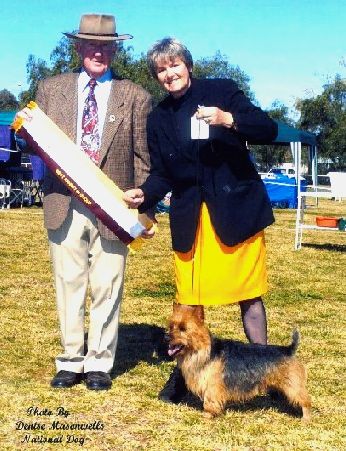
“Tommy”
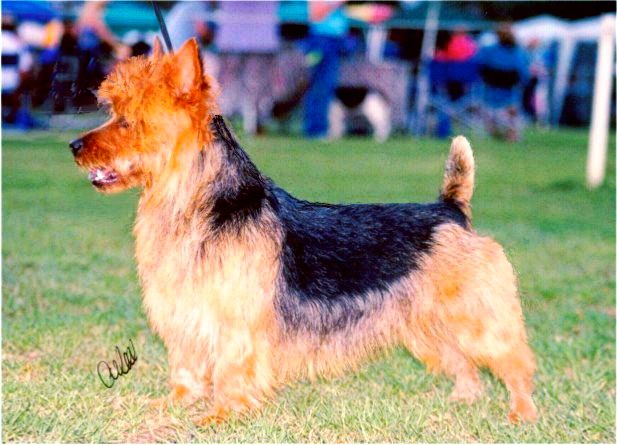
“Tommy” after receiving a Group1 placement. We sent our champion female (Maggie) we then owned along with two puppies from her first litter (bred to Tommy’s father) to Kendall and Mike with the aim of a undertaking a mating with Maggie using the semen from Kendall’s Am Can Mex Intl Ch Touchstone Special F/X.
This mating only produced one bitch and we believed that she should remain in the USA. Maggie was later mated again to Ch Azul Smart Remark and we imported our Jenny from that litter.
Jenny has excellent conformation and good size with a true blue coat and a wonderful temperament. She is everything we hoped for.
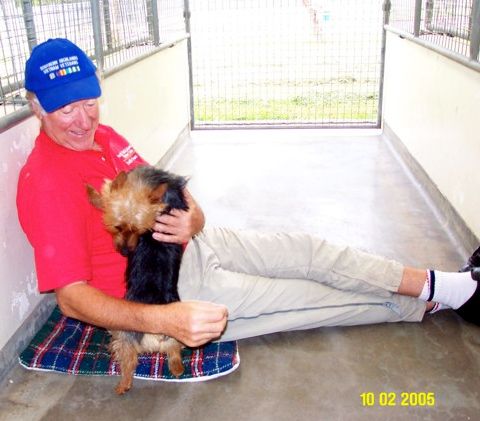
Trevor Fenton and Jenny in quarantine.
What was the quarantine experience like for Jenny and for you and Trevor?
Judge Diana Fenton: Jenny was well looked after. We visited her each week and took in extra food for her (milk, eggs and lots of chewy things) plus toys and a special bed. The requirement is for 30 + days in quarantine so it was not too long. We do not have rabies in Australia so Jenny had to be immunized and her titre levels had to be above a specified level before she could leave the USA. The worst part for us was waiting to make sure that she arrived safely to the quarantine station. Then we had to wait 7 days before we were allowed to visit her.
Was Roope the pick of the litter? Did you select him for the owners in Finland or did they pick him from the litter?
Judge Diana Fenton:There were only 2 males in the litter and yes, Roope was our pick. We sent many photos to Jenny and Seija but it is always hard to know what you are really getting from a photo. Jenni and Seija trusted us completely and we just crossed our fingers.
Jenni, how did you meet Mrs. Diana Fenton?
Jenni Wahteristo: In June, 2005, the Finnish Australian Terrier Club invited Diana Fenton to judge their unofficial club show held during the Summer Day Event. Diana and her husband, Trevor, stayed with Irma Harden, owner of kennel Tehill’s. A couple of months prior to the planned Summer Day Event, Irma called me and asked for day trip ideas in the Saimaa Lake area. Since I live in this area, I thought it would be fun to host Diana and Trevor. Not only did I want to show them around this part of Finland, I also wanted to serve them a traditional meal of moose meat casserole. Naturally during our time together there were many discussions about Aussies, with one discussion leading to another….

Horrieglen Blue Legend “Roope”
“Roope” and his sister “Matilda” before they left Australia
What was the trip like from Australia to Finland? How did the dogs do?
Jenni: “Roope”, Horrieglen Blue Legend and his sister, “Matilda”, Horrieglen Blue Bonnet left Sydney, Australia on September 26, 2006. They flew via Singapore and Heathrow in London to Helsinki, Finland. This “trip of a lifetime” took 34 hours to complete. Even after an exhausting journey they both were happy and alert when they arrived in Finland. They greeted Seija Ristola and Irma as if they had known them for a long time. Seija remembers, “From the first sight I knew that “Roope” was, and will be, an alert, happy and really wonderful dog.” Irma remembers, “Both pups were from the first moment brave and curious, and very happy pups. I remember how they played with and tried to catch autumn leaves that whirled in the wind at the airport parking area. Amazing! They just came out from the customs and now they were playing as if they had been living in Finland all their lives.”
Can you describe “Roope’s” show career?
Jenni: Roppe’s show career began in 2007 when he won a reserve-CC, of which he won 4 pcs. In 2009 he won a reserve-cacib and on September 11, 2010, he became a Finnish Champion. Abroad, he has won 5 cacibs and 5 Best-of-Breeds.
Roope became C.I.B and DK CH when he won BOB at an International Dog Show in Denmark the 5th of November 2011.
Roope has traveled to Estonia, Latvia, Lithuania, Sweden (WW-shows) and Denmark. It is really easy to travel with him as he is calm and relaxed lying in his box, sleeping or watching what is going on around him. He loves to stay at hotels, especially since he can then sleep in the same bed with Seija or with me!
Seija says, “Roope has still happy moments ahead. At least I still wait for his offspring that will follow his paw marks in the ring when he retires.” I am already very happy with what Roope has left with his offspring; for instance, Donna, (FI & DK CH Finsweng Dancing Queen) is a wonderful family dog, a great mum, and a top companion on trips and in show rings. Many of Donna’s kids have also started their own very promising show careers.
Some may think that Roope’s show career is not that brilliant, but nothing can be better than his happiness, positive state of mind and attitude. Both Seija and I are incredibly happy to own such a dog as Roope. “We are very lucky and very happy that we met Diana and Trevor. Not only did we get this wonderful dog, but a warm and lasting friendship.”

“Roope” in Finland
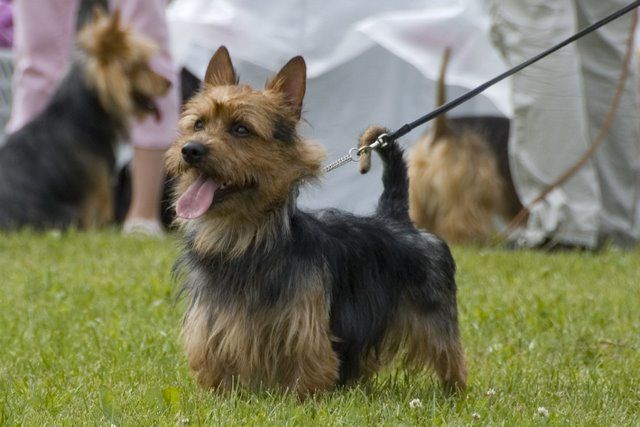
“Roope” as a junior.
Photo taken by Irma Harden
C.I.B. FIN & LT & LV & DK CH, BALTJW-07, BALTW-08,
BALTW-10, DKW-11 Horrieglen Blue Legend
Sire: Australian Grand Ch. Horrieglen Flash O Blue
Dam: Australian Ch. Touchstones BluewrenOhoriglen (imp USA)
Bred by: Diana and Trevor Fenton, Australia
Proud Owners: Seija Ristola and Jenni Wahteristo, Finland

“Roope” Best Of Breed in Denmark 2011, receiving his
International Championship Title.
Can you tell us about “Roope’s” offspring?
Jenni: “Roope” has sired 32 puppies, from 7 litters, all in Finland. The first litter was born in 2008 and the last at the end of 2011. “Roope” left many of his good features to his offspring, especially his fantastic character and temperament, as well as, a legacy of good health.
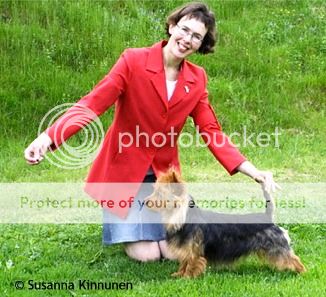
“Donna” and Jenni
FI & DK CH Finsweng Dancing Queen
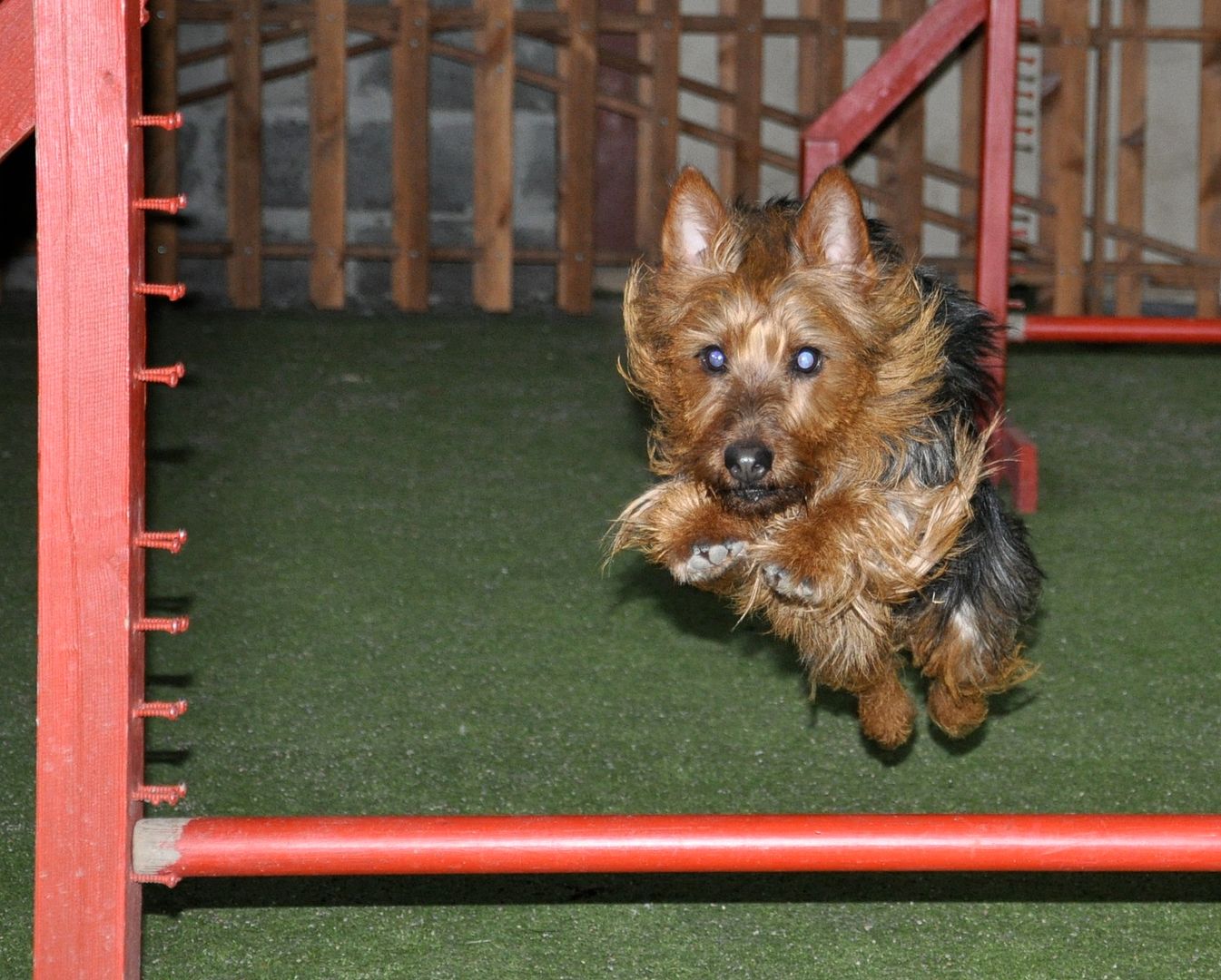
“Hannes” doing agility which he loves!
Finsweng Paroni von Luu
Photo by O.Humalamäki

Avocation It’s My Life Photo by M & T Onkamo
|
|
Love Means Never Having To Say I’m Sorry
|
The Adventures of Lenny and Darcy Carmichael
My husband and I needed to go to the grocery store. We always confine Lenny and Darcy, our two Australian Terriers, to our bedroom where their doggie door is so they have access to the fenced backyard when we are gone. They enjoy having access to our bedroom for their personal comfort, warmth and fresh water.
This particular night, immediately upon opening the bedroom door, my husband and I thought we had been transported to Alfred Hitchcock’s movie “The Birds.” Feathers were everywhere and I do mean everywhere. Did they have a pillow fight and break open the pillows? Did they bring a live bird in the house or maybe ten? How else could the room be filled with this many feathers? The pillows were intact leading us to believe we were at a “crime scene” and a bird murder had occurred in our bedroom. Aside from the feathers, there was no evidence of a bird. This presented so many questions with no answers.
We do know that our “Lenny” with spring loaded back legs has jumped and snatched many squirrels from the wire they scamper across in our backyard. None of those squirrels have come to a happy ending.
I cleaned and disinfected everything but never found anything other than feathers. How can these two dogs catch and kill a bird with no other remains than feathers?
We assume that Lenny did the killing because he is so quick. Lenny would give anything and everything to Darcy because you have never seen two dogs more in love than these two. We assume Darcy “polished it off.”
We wonder, on a daily basis, what our next adventure will be with these two adorable Australian Terriers. We are so fortunate to have them in our lives. Life is never dull. They always entertain us and love us. We will always love them no matter what their escapades bring us next.
“Lenny” studying up on how to remove bird feathers.
|
|
Scott Pruter Shares Her Love For “Finn”
|
|
Finn (above and below) an Aussie for all season’s.
Finn was imported from Kirsi Ola (Finland).
Photos Courtesy Of Scott Pruter (USA)
|
|
We Love Rescuing by Jeri Leu
|
Photo Courtesy Of Jeri Leu “Sadie” and “Timmie”
We lost our first Australian Terrier, “Tillie,” in 2003. I felt her loss every day until 2006 when I got an email from Darlene Evans and a photo of “Sadie,” a rescue that needed a forever home. She was from a puppy mill somewhere near Oklahoma and was being fostered. After making plane reservations and many phone calls to finalize the plans we got “Sadie” on May 22, 2006. It was love at first sight for all of us!
In 2010 I was looking at the Rescue site and saw the “Colorado Six” Aussies that were up for adoption. I was hesitant about getting another dog, as it is pretty easy with just one. But we decided to take the plunge. Our next rescue, “Timmie,” arrived scared to death and would not make eye contact with us. I’m sure if he had gotten away from us we would’ve never caught him. We didn’t know how “Sadie” and “Timmie” would react when they first met. When we got home from the airport, we put “Timmie” in the front yard with “Sadie.” It was like the sun came out after a long winter! (We were told beforehand that the “Six” were all very congenial with other dogs.) He fell in love with “Sadie” the moment he saw her and he still adores her. It took awhile for “Timmie” to learn that it was okay to be loved and now he just “soaks” it up!
Now, we think it is even easier living with two dogs than one. We wonder how it would be with three or four.
|
|
Shastakin Jersey Jake by Doreen Calvin
|
Doreen and Terry Calvin talk about their love for their dog, “Jake.”
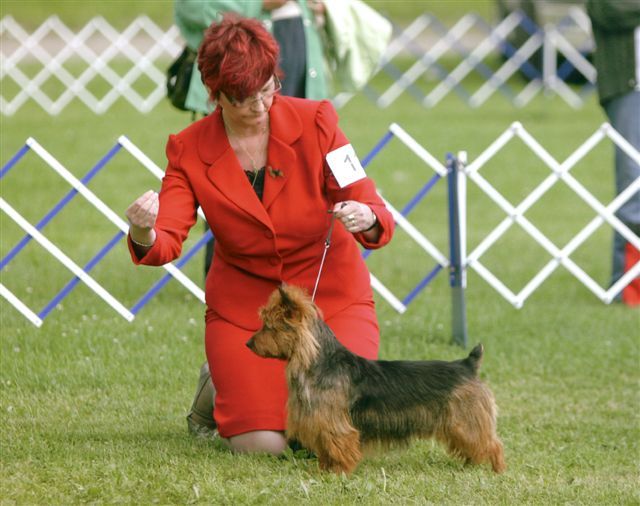
Photo Courtesy Of Doreen Calvin “Jake” in Orono, 2011
How old is “Jake”?
Jake will be 6 years old in May 2012.
When did you get him and from whom?
I got Jake from Esther Krom when he was 8 weeks old in 2006.
Is this the first dog you’ve shown?
I have had Aussies for over 30 years but Jake is the first Aussie that I have shown. When my little Bailey died, I was very saddened and said I would never get anotherdog. Puppies were available a few times but I was not interested. I went to a few shows to watch the Aussies and especially my friend Chris Nicholson’s show dogs as my Bailey was from Chris’s Kennel (Northover Kennel).
In July 2006, 14 months after Bailey died, I woke up and knew I was ready to get another Aussie. Not only was I interested in getting a little boy, but I wanted to show him. I phoned Chris Nicholson and she gave me Esther’s phone number. Afterour discussion, Chris and I drove half-way to New Jersey to meet Esther and her pups. The rest is history.
When Jake was 13 months old, there was a dog show that Chris and Esther were entering. I threw my hat in the ring and Chris showed me the ropes of showing a dog a few days before the show. We practiced in her backyard and the road in front of her house. I showed my boy all 3 days of the weekend show and he won the breed each day. Jake received his Canadian championship the same year.
I did take Jake to obedience training in his first year and this really helped me in the ring.
Has it been fun?
I love showing my boy. No matter how he does, he comes home with me which is the greatest gift and better than any prize.
I would not be honest if I said there were not some frustrations with the dog shows; however, overall I have thoroughly enjoyed the shows. A judge who also shows his dogs once offered the following advice: show your dog to the best of your ability, celebrate your wins, accept your losses graciously and move on.
One of my proudest moments in the United States was going Best of Winners at Montgomery and at Devon.
When Jake won a Best in Show in Canada, I had many people to thank, as no one wins on their own. I thanked Esther and Carol (Jablonowski) for breeding Jake. My husband, Terry, and my Mom I thanked for their support. I also thanked the many friends I have met at the shows who openly shared their experience and encouragement and the many judges who provided critiques of my show skills so I could improve.
What have you enjoyed about him and showing?
I had and have a very busy job (in healthcare administration), working long hours to the point I needed balance in my life. Showing Jake is a hobby that Terry and I do together as a team. Terry is always there to help me with Jake and has shown him a few times.
I love the bond that I have with Jake. In the ring, there are times I feel we are moving as one. He is not an easy dog to show (so I have been told) as he has a strong disposition and there are times he gets a look in his eye and I know I am in for trouble. What makes Jake a great show dog can also be to his detriment in the ring. When at home, which is most of the time, Jake is my boy who lounges around with me after our busy day.
Jake is a true terrier. He is busy, lovable and mischievous (goes in all the bathrooms and pulls the bathroom tissue off the rolls throughout the entire house). Carol Jablonowski said his father, Cash, also loves paper products and he is 13, so I am doomed.
I have met some wonderful people through the dog shows including breeders, owners and handlers. I have made some very good friends at the shows and learned a lot about other breeds. As owner/handlers, we encourage each other and will always stay to the end if one of us wins the group and will be in Best in Show.
In fact, I like to help others show their dogs when I have time.
Can you share a little about his successes in Canada?
If I never showed Jake again in Canada he has achieved more than I ever dreamed. Jake has been the number 1 Australian Terrier every year since 2008.
Each year, to keep us challenged, we set our goals. In 2011, we had the following goals: to win a Best in Show and we won 2; to finish Jake’s American Championship (as we do not go to the U.S more than 2 to 3 times per year), which we accomplished in August with a Group 2 win; to get a title-Jake received his Canine Good Neighbour (CGN) in October, and to get his Grand Championship in Canada which he achieved in October. In 2011, Jake won over 70 group placements, was number 1 Australian Terrier and number 6 Terrier overall in Canada.
Jake can now sport the title MBIS CAN GCH / AM CH SHASTAKIN JERSEY JAKE C.G.N.
Esther and my friends still laugh because when it came time to make my final decision on which puppy to take home, I chose Jake because he was the only male who nuzzled me.
Photo Courtesy Of Doreen Calvin (Canada)
|
|
We Love Cooking With Cheryl
|
|

“The Food Critic “
Photo Courtesy Of Cheryl Mechalke
Homemade Dog Treats -Four Herb Tuna Tots
Don’t let your cat fool you, dogs love tuna, too. You’ll love giving these tots to your dog because tuna is very high in protein and is easily prepared into dog treats. Tuna also contains a high amount of Vitamin D, and is a good source of omega-3 fatty acids.
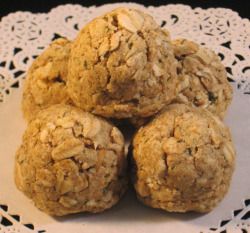
Ingredients:
- 1 1/2 cup rolled oats – 360 ml
- 1 cup cornmeal – 240 ml
- 1/2 cup whole wheat flour – 120 ml
- 1/2 tsp dried dill – 2.5 ml
- 1 tsp dried oregano – 5 ml
- 1 tsp dried thyme – 5 ml
- 2 tsp dried parsley -10 ml
- 5 oz can tuna in oil (do not drain) – 150 grams
- 3 tbsp extra virgin olive oil – 45 ml
- 1/4 cup water – 60 ml
- 1 egg
Instructions:
1. Preheat oven to 350° F – 177 ° C
2. In a large bowl, whisk together the oats, cornmeal, flour and herbs.
3. In a blender puree the tuna, oil, water and egg.
4. Make a well in the center of the oat mixture and pour in the tuna mixture.
5. Stir until combined.
6. Lightly spray a baking sheet with non-stick cooking spray.
7. Using a 1 inch/ 5 cm cookie scooper, pack the dough into the scooper with your hands and release on the baking sheet.
8. Bake for 25 minutes.
9. Cool completely on a wire rack.
Storing – These homemade dog treats will keep fresh in the refrigerator for about one week. Keep them fresh in the freezer for up to 4 months.
Yield – Using a 1 inch/2.5 cm cookie scooper, you will yield about 32 tuna tots.
Tips & Techniques
- Substitute the Tuna – Make varieties of these dog treats with canned salmon or chicken. If you use other meats that are larger than a 5 oz -150 ml can of tuna, omit the 1/4 cup /60 ml of water. You may need to add a bit more flour, too.
- Different Herbs – You can use other herbs, too. Try rosemary or tarragon for variety.
- Fresh or Dried – If you prefer to use fresh herbs, you can. Substitute fresh for dry on a 3 to 1 ratio. For example, you would need 1 tablespoon of minced fresh thyme instead of the 1 tsp of dried thyme that the recipe calls for.
- Hand Packed – Be sure to hand pack this dough into your cookie scooper. It is very thick and needs to be packed together to create a solid homemade dog treat.
Besides being very tasty, this tuna dog treat recipe will help make your dog’s fur shiny. Also, because the aroma of tuna is so tempting, once your dog has had a taste, we’re sure you can use these tuna tots for dog training treats or just rewards for being your special companion
Copyright Dog Treat Kitchen.com For more information about this recipe Click Here.
|
|
We Love Books
|
| 1. “I Am an Australian Terrier” by Theresa A. Goiffon. To Purchase Click Here.
2. “Guardians of Being: Spiritual Teachings From Our Dogs and Cats” words by Eckhart Tolle and art by Patrick McDonnell.
3. “The Canine Thyroid Epidemic: Answers You Need for Your Dog” by W. Jean Dodds.
To order or read reviews from Amazon.com Click Here |
|
The Aussies Loved By Kimmo Aaltonen
|
| Eija and Kimmo Aaltonen share photos of their beautiful Aussies.
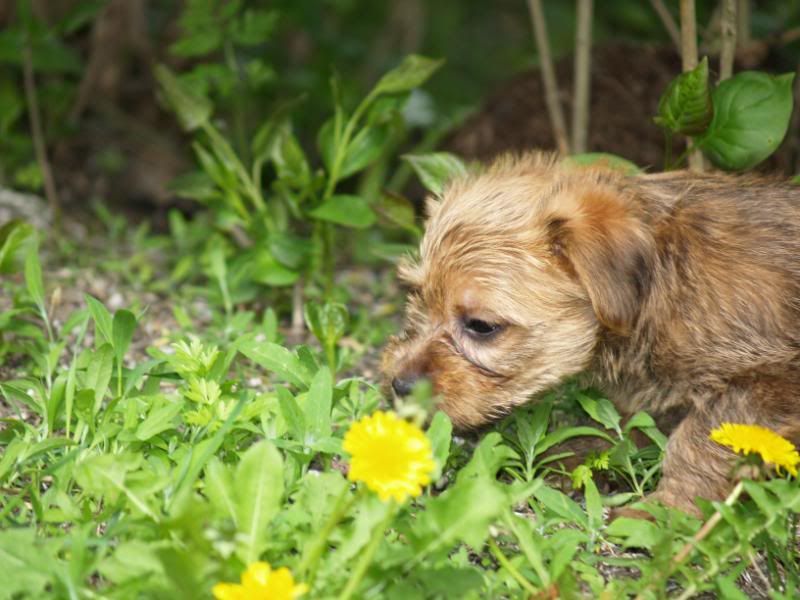



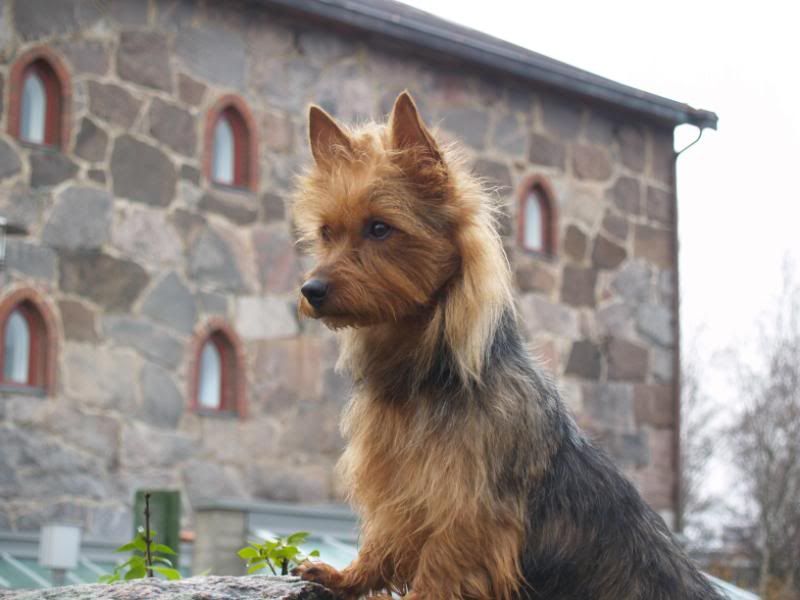
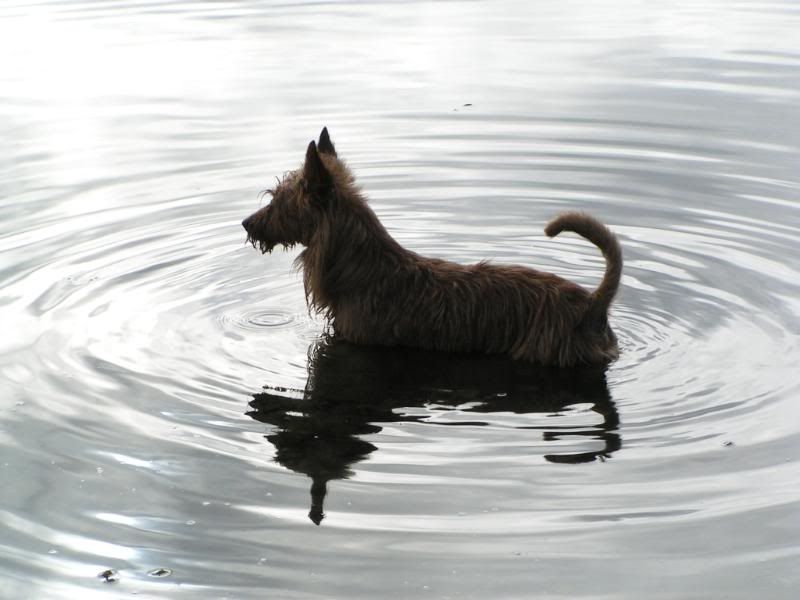
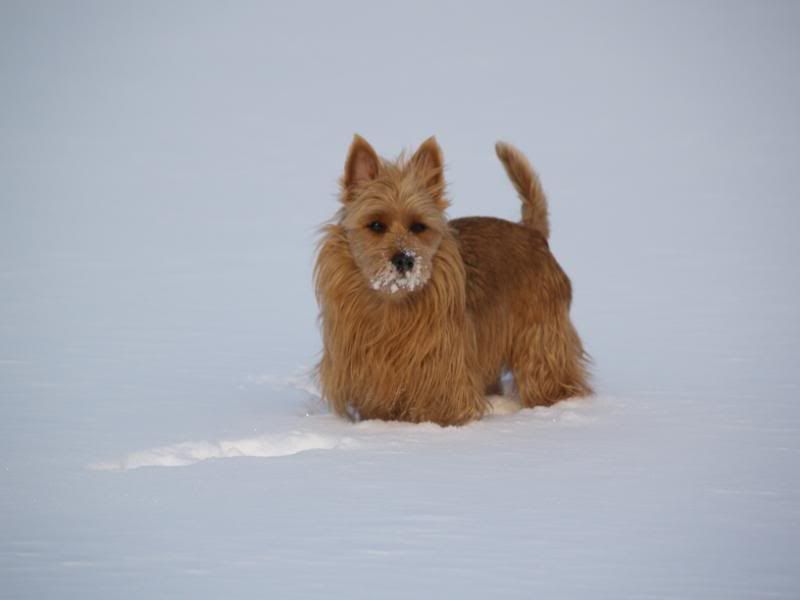
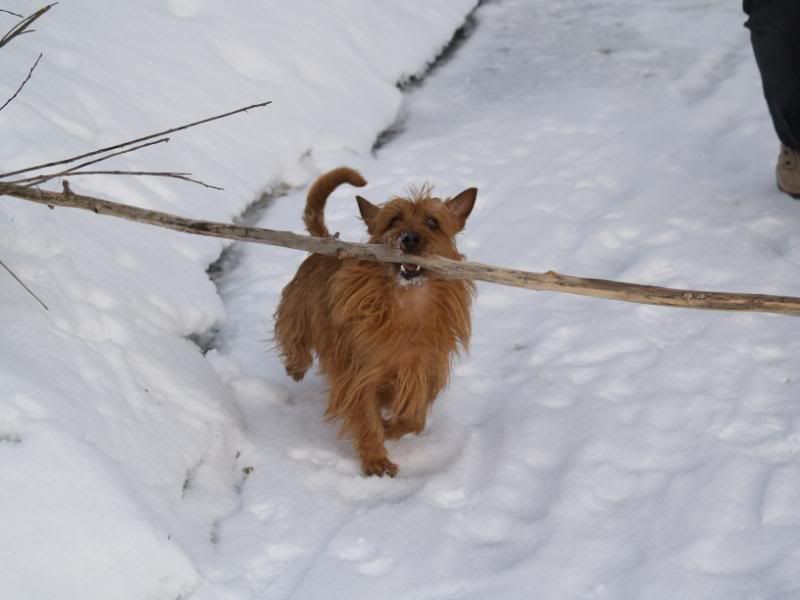
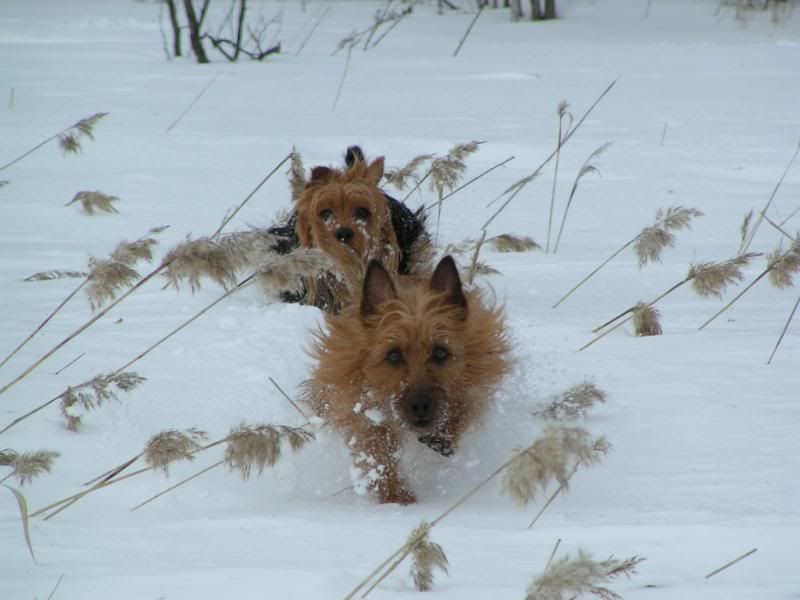

All photos have copyrights and are taken by Kimmo Aaltonen |
Love Is Supporting Responsible Breeders |
|
Australian Terrier Adoption Application
By Theresa A. Goiffon

To be a responsible breeder, there are many aspects to consider. Responsible breeders are naturally concerned with the health, temperament and structure of their puppies; it is equally important that they find the perfect forever home for their puppies as well. It’s our job to try and place the right puppy in the right home. That is essential not only for our puppies, but for the families that will love them forever.
Should you decide to add an Australian Terrier to your family expect to complete an adoption application, sometimes referred to by breeders as a puppy buyer application. Breeders that require this application process are not trying to offend potential families but are trying to make sure that the right home and the right puppy are placed together. This requirement tells you that breeders care about their puppy’s future care and life long happiness. Most of the breeders I have spoken with, in gathering information for this article, have a written Adoption Application. Some do not have written applications, but all have questions for prospective buyers, and some are more detailed than others.
We all know that not all dog breeds are alike. There might be circumstances or life styles that fit one breed better than another. Therefore, questions the breeder might ask a prospective family wishing to adopt an Australian Terrier may vary from thoseadopting a different breed.
Here is a list of questions that you as the prospective family might expect to answer. If you are a breeder, and would like to know what type of questions other breeders are asking, here is a list of questions you might consider including in your adoption application.
General Information:
- What is your name, age, address, telephone number and email address?
- Who referred you or how did you find us?
- Who can you list as references (please list two) that we may contact?
- What is the name and telephone number of your veterinarian?
- What is your time frame for adding an Australian Terrier to your family?
- What sex are you interested in?
- Are you interested in a puppy, adult or does it matter?
Questions:
- Why do you or your family want a dog?
- Why did you choose this particular breed?
- Have you owned a dog before? If so, when, what kind and for how long?
- Do you currently have pets? If so, how many and what are they?
- Do you have children or grandchildren? If so, how old are they? How would they be instructed in the care of a new puppy?
- Do you have a fenced-in yard? If not, how often do you plan to exercise and walk your dog?
- If you live in a condominium or an apartment, do you know the rules and stipulations for having a dog? Also, where do you plan to exercise your dog?
- How long do you feel a dog should be outside each day?
- How often is someone at home to care for the puppy?
- How much time will you have to play and walk your dog?
- Will your dog be enrolled in puppy or obedience training?
Additional Remarks:
It is a heavy responsibility to decide on a delightful young being’s future. It is our responsibility to those we help bring into this world to make sure they have the best life possible.
One breeder suggested that because animals have very few rights, every dog owner should have a license to say they are psychologically ready and stable enough to own a dog. The breeder added that they should pass a 3 month course in dog training also. I am pretty sure these two statements were made with a bit of tongue in cheek, but these statements tell you just how important it is to a conscientious breeder to find the right home for their dogs.
In the next ATI newsletter I will review pet dog/puppy sales contracts. What are breeders requiring their adoptive families to comply with and why?
|
|
Love Is Education
Are You Thinking Of Spaying or Neutering Your Dog?
|
| You may want to do some research and read these articles first.
“We rarely get to hear about the well-researched and scientifically documented drawbacks of puppy neutering.
They include:
· A higher incidence of obesity
· Measurably reduced bone mass and density
· A significant increase in vascular tumors and bone cancers
· An increase in hypothyroidism, especially in larger breeds
· A delay in the closure of growth plates, resulting in taller, thinner dogs. Tibia-to-femur length ratios are often changed, resulting in ligament stress that can lead to possible rupture.
· Thinner chests, and smaller heads
· A higher incidence of incontinence in females
· A higher incidence of adverse reaction to vaccines
· An increase in the occurrence of hip dysplasia
· A marked increase in canine geriatric dementia”
Early Spay-Neuter Considerations for the Canine Athlete by M. Christine Zink DVM, PhD, DACVP, DACVSMR
Click Here
Castration-Hysterectomy Facts by Barbara (BJ) Andrews
Click Here
Rethinking Spay and Neuter by Geneva Coats R.N. Click here
The Cruelty of Castration by Barbara (BJ) Andrews Click here
Tubal Ligation or Vasectomy Offers New Solution by Lana Turner Click here
A Healthier Respect for Ovaries by David J. Waters, DVM, PhD, Diplomate ACVS
Click here
Cancer and Phytochemicals by Susan Thorpe-Vargas PhD. Click Here
|
|
We Love These Toys
|

Bottle Critters are no-stuffing dog toys that feature a pocket for a used water bottle. The toys are soft, floppy, and lots of fun for dogs to flop around, the company reports. Measuring 22-in. long, they are currently available in eight designs, including an upright chicken (shown).
Manners Minder
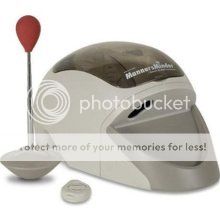
Watch Devorah Sperber training her Aussies using the Manners Minder: click here
|
Love Is Honoring Our Breeders Who Get Awards |
| Krista Riihela, from Finland and the owner of Reimin Kennels, has been awarded the prestigious breeder award, Vuolasvirta-prize, from the Finnish Kennel Club. She received the award in December 2011 at the Helsinki Winner Show.
ATI congratulates her!
She is the seventh Australian Terrier Breeder to receive this wonderful award.
The others breeders to receive this award are:
From the oldest:
Kennel Sassatown, owner Mr Harto Stockmari (prev. Hallikas) 1989
Kennel Reimin, owner Mrs Ingrid “Mimmi” Salo 1990
Kennel Avocation, owner Mrs Orvokki Lämsä 1995-1996
Kennel Bluepepper’s, owner Ms Marjo Ahola 1998
Kennel Selendia, owner Mrs Pia Nyberg (prev. Lindqvist) 2001
Kennel Melukylän, owner Ms Kirsi Ola 2010
The Vuolasvirta-prize is the highest prize the Finnish Kennel Club gives to dog breeders. To get the nomination for the award, the breeder has to have ten sequential litters for which a score of success in dog shows and other competitions is calculated. The breeder has to be a member of Finnish Kennel Club uninterruptedly for ten years and also be a member of the breed club. The breeder has to have a kennel name and her/his breeding activities have to be faultless and exemplary as mentioned in the Kennel Club’s “breeder’s commitment.” A kennel advisor has to visit the kennel and give a recommendation before the prize can be given.
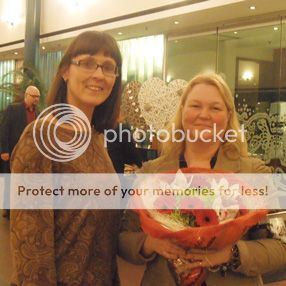
Kirsi Ola and Krista Riihela
Her veteran, Heta, C.I.B. & FI & EE & LV CH Reimin Helter Skelter, won Best in Show 3 out of approximately 100 other veterans in the show.
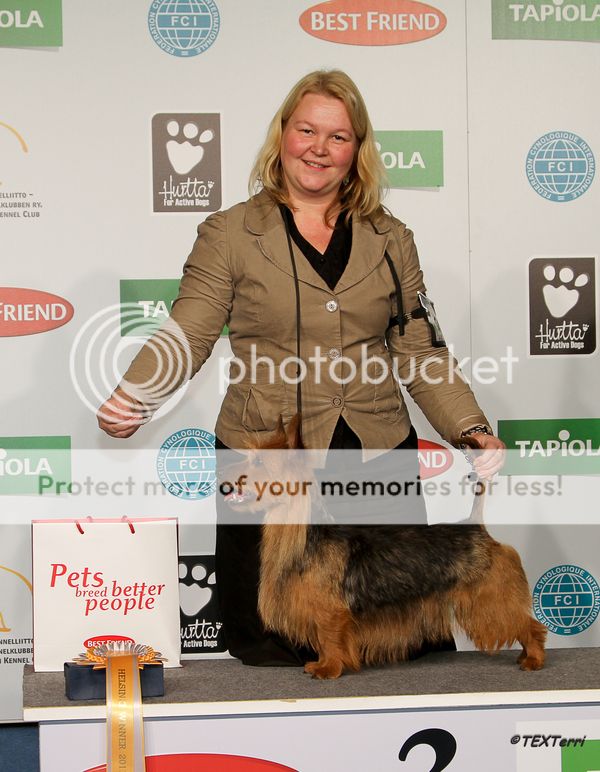
Photo Courtesy Of Krista Riihela
Mr. Reino and Mrs. Ingrid (Mimmi) Salo began the Reimin Kennel in 1974 with the purchase of two puppies (see The Australian Terrier, History and Origins, pages 255-262 for further details).
“Mrs. Salo was awarded the Vuolasvirta-prize on her sixty fifth birthday. She was made an Honorary Member of the Australian Terrier Club of Finland in 1993 and the Finnish Kennel Club in 1995. In 1995 she turned seventy years of age and although still keeping a strong interest in Australian Terriers, has wound down her kennel and passed her kennel name on to her good friend, Krista Riihela, who in 1997 imported AUST CH FI CH Tahee Trade in Red.”[i]
Krista has a wonderful history of being mentored by her mother Mrs. Marketta Sorjonen and Mrs. Salo. She has carried on the tradition of importing wonderful Australian Terriers into Finland. She has imported four Australian Terriers from the USA from Sue Holsinger’s Redwing Kennels. (See the article on International Partnerships in ATI’s December 2011 newsletter to view photos of co-owned dogs and learn more about Krista or click here)
FI & EE CH Redwing Mona Lisa Smile (Julia), 2006
FI & EE CH, FI & EE JCH Redwing Rhinestone Cowboy (Jekku) 2007
C.I.B & FI & LV & LT CH LTW-11 Redwing Kiss and Tell (Romeo) 2009
FI CH Redwing Under Your Spell (Noita) 2009 – sister to Romeo

Krista frequently co-owns dogs, with Satu Harden of Surely Kennels and with Satu’s mother, Irma Harden, of Tehill’s Kennels. They are all great friends who breed and raise litters together. Irma has mentored both Krista and Satu in the art of breeding and selecting puppies for conformation. Krista prefers to have Irma lead in the art of breeding because of her many years of experience. Satu is often seen in the show ring grooming area with Krista at the shows. Satu and Krista help each other show their Aussies as there are no professional dog handlers in Finland. Most dog owners show their own dogs, so showing more than one dog, as we in the USA know, is difficult. A helping hand from a friend is most welcome. Irma is seen outside the show ring today, often keeping track of the human children while their mothers are in the ring.
Krista has learned how to welcome and maintain new Australian Terrier families into our terrier family. It seems to have served her well in becoming a respected Australian Terrier breeder.
To see Krista’s wonderful Aussies, please visit her website,
http://kotisivu.dnainternet.net/riihela-1/
Endnotes
[i]. McDougall Douglas, Pamela, The Australian Terrier History and Origins1997 (K A & P D McDougall Pty Ltd, Londonberry, Australia ISBN # 0 646 318772).
|
Jenni Hedlund and Her Very Loved Aussies From Sweden |
|
All Photos Courtesy Of And Photographed By Jenni Hedlund.
|
|
In Love With Our Environment
|
| How does one best dispose of dog poop?
“The National Resource Defense Council (NRDC) suggests that one way to deal with your puppy’s poop is to flush it down the toilet.” Just be careful not to plug up your toilet. “Wastewater treatment plants (in the US) kill harmful bacteria found in dog excrement and leftover sewage waste is composted.”
Another option is to invest in a mini septic system for your pet like an underground pet waste digester or dog dooley.

Doggie Dooley In-Ground Waste Digester System “If tossing excrement in the trash is more convenient, the Environmental Protection Agency suggest purchasing biodegradable bags as an alternative to picking up poop with plastic bags. Plant-based, biodegradable bags may take decades to breakdown in the landfill, but you are supporting plants instead of oil.
Be sure to avoid home composting and never leave your dogs feces on the trail or in your yard. Pathogens like roundworms, salmonella and E. Coli can be found in doggy-doo. Storm water runoff can carry the poop down into the storm drain. Since not every system leads to a water-treatment plant, the bacteria, viruses, and parasites can be deposited into local bodies of water.”
“Pet waste also contributes to water pollution by providing ample nutrients to grow a monoculture of algae. When an algae population overcrowds a pond or stream it causes eutrophication. Its murky green cloud inhibits the ability of light to travel through the water, therefore limiting photosynthesis for other plants. Decomposing aquatic plants and the organisms feeding on them also deplete the oxygen levels, ultimately making it difficult for fish to breathe.”
This information was shared by Eartha Steward, a publication written by Jennifer Santry and Caitlin Akkerhuis, consultants on all things eco and chic at the High Country Conservation Center.
BioBag Dog Waste Bags
These bags hold the distinction of being the first certified compostable “plastic” pooper bags in the world. It is one of their most popular products.
“Picking up after your pet is part of being a responsible pet owner. In many communities, it’s also the law. We are constantly amazed when pet owners put 100% biodegradable dog waste into plastic bags that can take over 100 years to decompose. Now owners have a logical solution,” BioBag Dog Waste Bags.
|
|
Remembering, With Love, Our Dogs Departed
|
|
You will be remembered when the flowers bloom in spring
In the summertime remembered
In the fun that summer brings.
You will be remembered
When fall brings leaves of gold
In the wintertime remembered, in the stories that are told
And you will be remembered, each day right from the start
For the memories that we once shared
Forever live within my heart
Judith Bulock Morse
|
|
Loving Motto To Live By
|
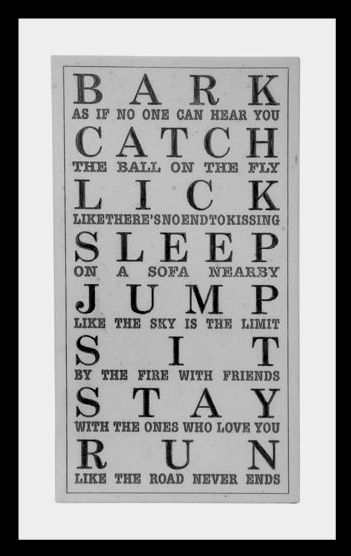
To Purchase Dog Philosophy Plaque |
We Love Our Juniors
Junior Statistics for 2011 |
Congratualtions to Our American Junior Handlers!
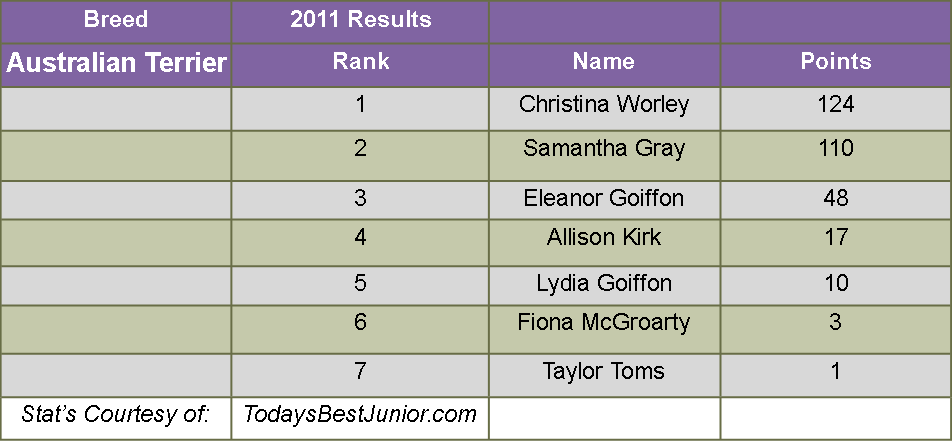
|
|
We Love Our Smart Aussies. How Smart Is Your Aussie?
|
|
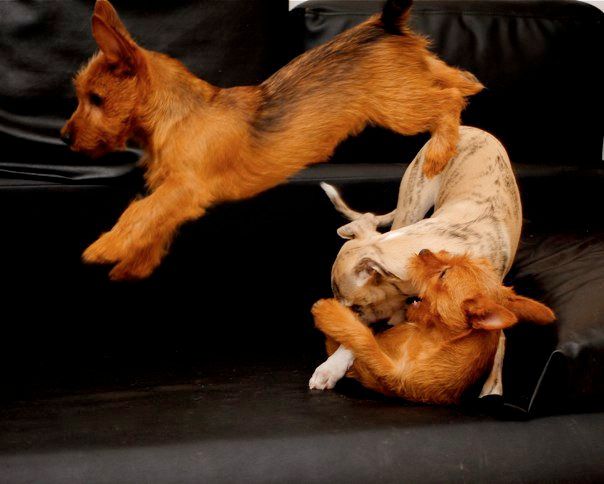
Photo Courtesy Of Henny van den Berg
It never ceases to amaze me just how smart our Aussies are so it also frustrates me that they are never on the top 10 list of smartest dogs.
How can it be that the dogs who obey and listen are always on the top 10 list?
Our brilliant Aussies think outside of the box. They are strong willed and many times don’t want to be taught, but they prefer to learn through the school of “hard knocks” and work things out for themselves. Surely that counts for something.
We know that dogs are very smart animals. We can find information in the literature backed up by scientists that estimate that the average dog is as smart as a 3 year old child. I believe our Aussies are as smart as 5 year old children.
The average dog is believed to be smart enough to understand more than 150 words. How many does your Aussie know?
Love is taking the time to work with your dog. Teach him many words. Test your dog frequently and see how many words he knows. Up, down, off, on, cookie, go outside, crate, kennel, walk are just some of the basics I’m sure your dog knows.
Does your Aussie know colors? Can he count? Share with us your story demonstrating just how smart your Aussie is and we will print it here.
|
|
Love Means Knowing What is In Your Dog’s Food!
|
|
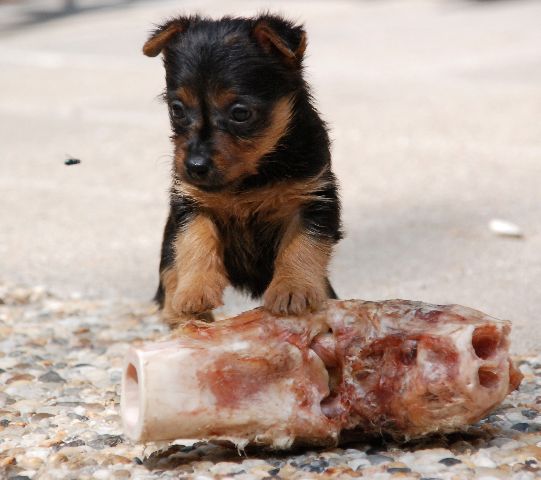
Photo Courtesy of Henny van den Berg
It is so difficult to know the right thing to feed your dog. Your veterinarian might recommend what he sells, so you think that is best. You hear others recommendraw diets, or you hear that a good wet food (canned) is better than the dry. It is so difficult to sort it out. Even more alarming is learning that in the USA our hamburger meat for human consumption and most likely also for animal consumption is tainted by Agent Orange. Then we wonder why our dogs are developing hemangiosarcomas and other cancers. Is there a connection? We do not know the answer to that question, but by sharing this information maybe we can help to keep our dogs as well as ourselves a little bit healthier.
Reprinted With Permission From Organic Bytes
Beware of Agent Orange Burgers
Dioxin, a chemical component of the herbicide Agent Orange, is perhaps the most toxic compound synthesized by man. Yet it is still being produced by chemical companies and pesticide manufacturers such as Monsanto, AND dioxin pollution increased 10% in 2010.
Now, as the Environmental Protection Agency is set to release the first part of the dioxin risk assessment it’s been working on since 1985, food industry lobbyists are attempting to block EPA action yet again. Why? The EPA is likely to confirm what the FDA has reported:
“Although dioxins are environmental contaminants, most dioxin exposure occurs through the diet, with over 95% coming through dietary intake of animal fats.”
The food industry doesn’t want you to know that you can easily exceed the daily dioxin limit proposed by the EPA by consuming a single large meal of non-organic animal products. Most of all, the food industry doesn’t want to have to take responsibility for the dioxin contamination. If they did, they would have to submit to common-sense food safety measures, like those embraced by the organic industry, that ban toxic pesticides and slaughterhouse waste from animal feed.
Tell the EPA to release its report on schedule and to not bow down to food industry lobbyists who don’t want us to know what we’re eating. Then watch this NutritionFacts.org video to learn which foods are most likely to contain dioxin. And, if you haven’t already, please take action on our “Stop Agent Orange Frankencorn” campaign to stop the new generation of genetically engineered crops designed to withstand being drenched with 2,4-D, the 7th-largest source of dioxin pollution in the US.
|
|
We Love Pet Friendly Hotels
|
| We have provided a list of hotels that take dogs. We really love when they take our dogs for free without additional cleaning charges!
|
Renew Or Join ATI |
|
WE HOPE YOU’VE ENJOYED YOUR NEWSLETTERS.
Please take a moment to renew.
All proceeds go to Canine Health Foundation (CHF).
Please pay before the next issue which we will send out
April 1, 2012.
WITH YOUR PAID MEMBERSHIP YOU WILL GET
*ACCESS TO THE WEBSITE
*BE ABLE TO DOWNLOAD FREE ARTICLES
*GET THE LATEST NEWS ON VACCINE PROTOCOLS
*BE ABLE TO SHOP IN THE AUSTRALIAN TERRIER MARKET AND SO MUCH MORE.
To Renew or Join Click here
To Join Us On Facebook Click Here
|
|
|

Pamela C. Levy
Australian Terrier InternationalPrivacy is important to us; therefore, we will not sell, rent, share or give your name or address to anyone. At any point, you can select the link at the bottom of every email to unsubscribe. Please note if you do not want to receive our emails, we do not want to bother you with them. Again, feel free to email us to be removed from the email list or unsubscribe using the link below. Thank you so much. |
|
|
|
|
![]()
![]()